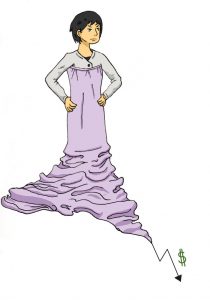When recession hits, hemlines lengthen
By Stephanie Trembath, Public Relations Manager
The global recession that has Gen X—namely, our parents—angry that the economic downturn since the late millennium is robbing them of their retirement, may be on the gradual road to recovery. According to what young femme fatales are wearing to the bars these days, and winter runway fashion for 2013, the recession that has kept our hands in pants pockets may be able to slip back on miniskirts.
Since the Great Depression of the 1920s, the Hemline Index has been used to mark the world’s economic state and the turning point during a recession. Street wear and runway designs are indicators of both social and economic status. It started with the “flapper” era, making headlines in the early ‘20s after Victorian prudishness and decorum was replaced with glitz and glamour, beaded skirts, higher heels, and feathered headbands. The dirty ‘30s saw the return of full skirts—after World War One robbed society of their luxuries.
George Taylor established the Hemline Index in the late ‘20s when he saw a correlation between fashion and the economy. The Great Depression had women of the generation hiding cheap stockings with longer skirts and material, and not surprisingly, war has a very grim psychological effect, and therefore influences more conservative behaviours.
The economic boom of the ‘60s influenced the miniskirt. Worn with neon tops and go-go boots, women of the era showed off lots of leg and loose hair. Mary Quant, a well-established designer from London, influenced the mod-movement of the ‘60s—imagine Twiggy’s early modelling career—and was the first to design “hot pants” and the miniskirt. Quant, known for her eclectic designs and free spirit in fashion, treated fashion as a game—something to generate pleasure in society.
In the ‘70s, Quant’s mini had designers inspired to create the micro-miniskirt, worn just above the thigh, Daisy Duke short shorts, also worn just below the crotch, and the minidress. After the minidress, designers started creating longer-cut dresses with brilliantly coloured designs and bare shoulders, called the maxi-dress.
Into the ‘80s and ‘90s, the miniskirt trend continued, with designers showing off pencil skirts for business attire, and short skirts with flounces, ruffles, and flare for the street. The millennium continued the classier-mini trend until 2008: when the US stock market crashed and the New Age generation experienced its first global recession. Winter and spring fashion for 2008 and 2009 saw the return of the maxi dress, and the boho-chic trend; long, flowing skirts and long-silhouettes in red-carpet designs. The flirty, flouncy, designer-wear for the past 40 years was immediately replaced by more material.
Economists today say that consumer confidence in market security has a lot to do with current fashion designs; spending hugely influences the economy, and designers quickly adapt their current designs to reflect the financial state of the economy. With more material and less leg, women are still confident in purchasing the latest styles in fashion, even during global recessions when the market is not as secure.
Meeting midway, summer saw the return of the short skirt with the latest asymmetric skirt design. Skirts worn above the knee in front and longer towards the ankle in back became a hot trend this summer, and continue into next spring. Since the asymmetric styled skirt is so versatile, top designer houses like McQueen, McCartney, and Armani took up the trend. No matter what your body type or style, the asymmetric skirt can be altered depending on what you’re looking for: a shorter hemline in the front for wider hips or ruffles in the back and bottom if you are tall and thin. In a variety of textures, materials, and colors, the asymmetric skirt may be worn right through fall/winter with tights and a long jacket.
Where can you buy this fashionably fun item? If you have more money to play with, try Neiman Marcus, Anthropologie, or Urban Outfitters. They have the most edgy designs and colors that will turn heads this season. If you are working with a budget, try H&M, Cheap Monday designs (sold online or through select stores), or try vintage or online shopping. Nasty Gal, an online store for progressive fashionistas with reasonable prices, offers the latest in trending fashion-wear and free shipping. Otherwise, and I’ve said this before, MAKE YOUR OWN. Buy a longer length skirt that you like, and then carefully cut so that it becomes shorter in the front, but be careful of the material you select as some materials do not hem as smoothly.



